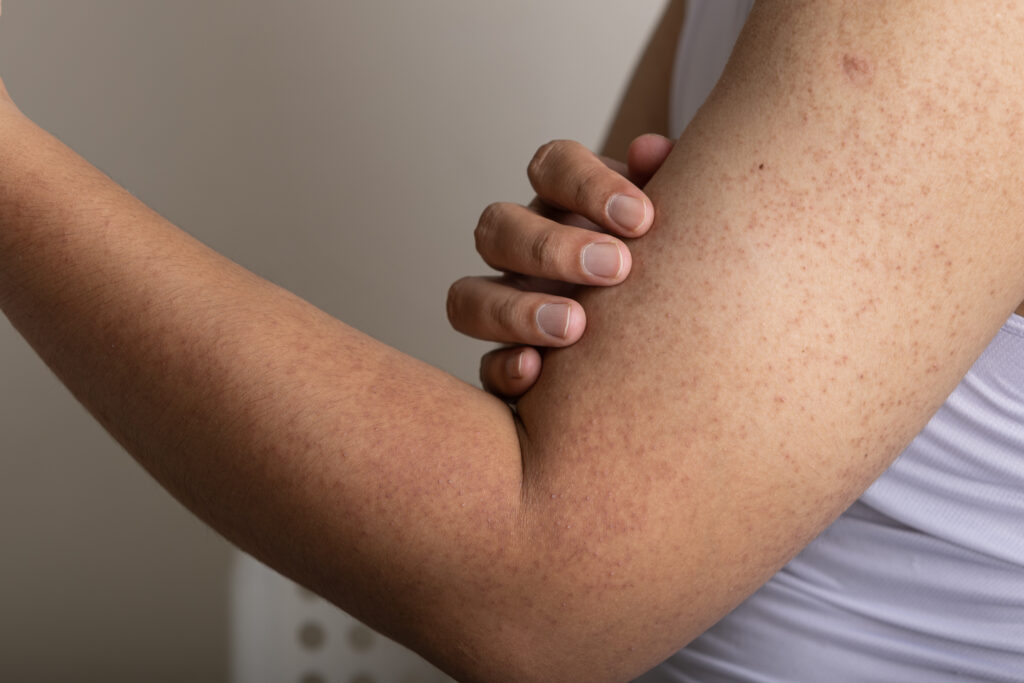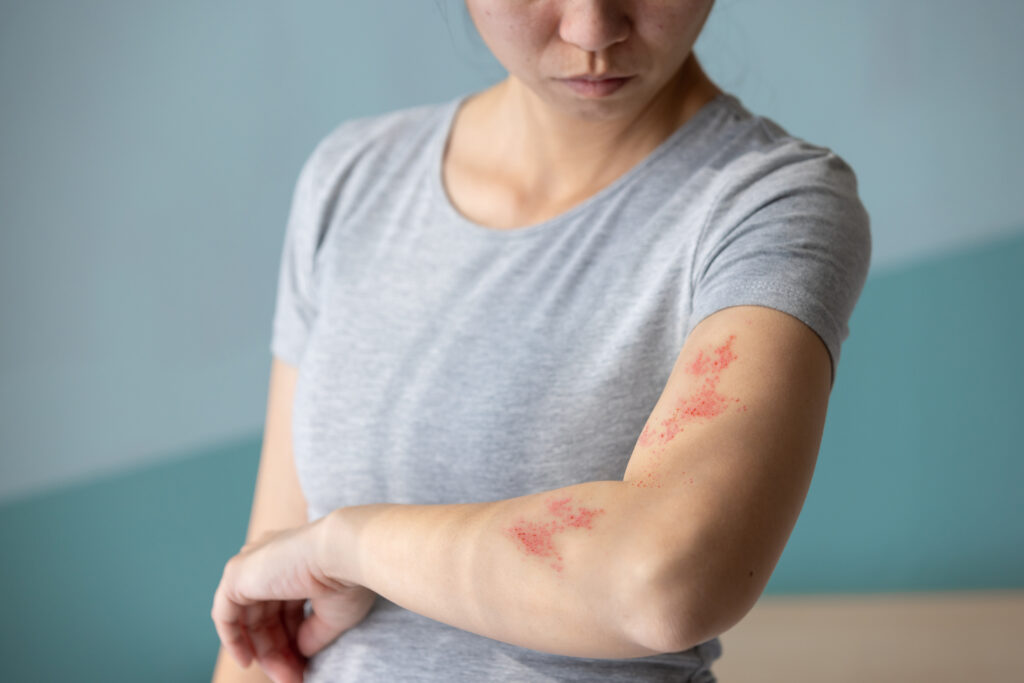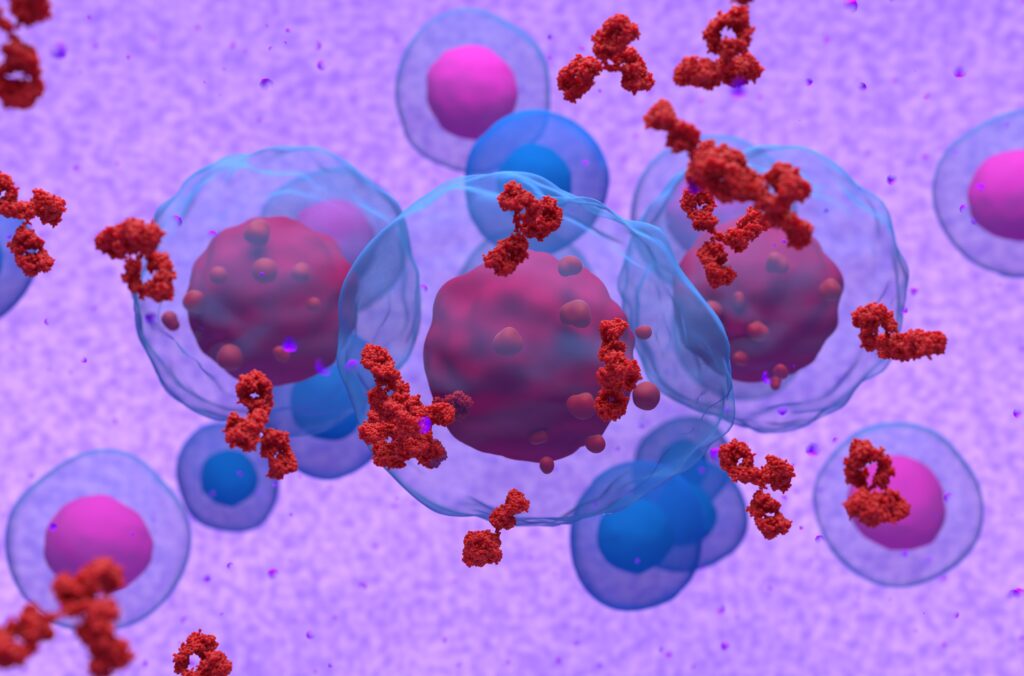
Keratosis pilaris is a common condition where small, rough bumps form on the skin. They may look like goosebumps, which often occur as a result of emotions—such as fear—or extreme temperatures, but they can also be mistaken for small pimples. It can also resemble the skin of a plucked chicken, earning the name “chicken skin.”
Symptoms of Keratosis Pilaris
Keratosis pilaris most often appears on the upper arms, but it can affect any body part with hair follicles.
In addition to the bumps, symptoms of keratosis pilaris include:
- Bumps that feel like sandpaper
- Discoloration around bumps
- Dry skin
- Itchy, irritable skin
Keratosis pilaris is not contagious and cannot be caught or passed on to other people. It can affect people of any age. It is most common early in life, either before the age of 2 or during the teenage years. It is estimated that between 50% and 80% of adolescents and 40% of adults have keratosis pilaris. The condition appears to run in families, so you may have a higher risk of getting it if you have a close blood relative who also has it. However, doctors aren’t sure why some people get it, and others don’t.
What Causes Keratosis Pilaris?
Keratosis pilaris is caused by a buildup of keratin in the skin. Keratin is a protein that makes up your hair, nails, and skin. When keratin builds up, it blocks the hair follicles, causing small bumps to form. The bumps may be the same color as your skin, or they may be brown, red, or white.
People with other skin conditions, such as eczema, may also be more likely to get keratosis pilaris. You may also be more likely to get it if you have very dry skin. Other conditions that can increase your risk for keratosis pilaris include ichthyosis vulgaris, hay fever, and obesity.
Some people may also get keratosis pilaris flare-ups due to hormonal changes during puberty or pregnancy.
How Is Keratosis Pilaris Treated?
There is no known cure for keratosis pilaris. The condition is harmless and doesn’t usually require treatment. For most people, it will go away on its own as they get older. However, if you want to improve your appearance, there are a few things you can do to relieve keratosis pilaris:
- Use mild and unperfumed skin care products—Artificial fragrances can cause irritation and lead to flare-ups. Perfumed products can also dry out your skin.
- Keep your skin moisturized and hydrated—Moisturizing creams that treat keratosis pilaris often include lactic acid or urea. Apply moisturizer after bathing or showering while your skin is still damp for best results. You can apply moisturizer two to three times per day if necessary, making sure to massage the moisturizer into the affected area gently.
- Avoid harsh exfoliants or constantly manipulating the bumps—While exfoliating can help reduce the bumps by removing dead skin cells from the surface of your skin, over-exfoliating the skin can cause further irritation.
- Apply medicated creams to the affected area—If your skin is not improving with over-the-counter treatments, your doctor or a dermatologist may recommend a prescription-strength moisturizer. Besides lactic acid or urea, these medications usually include one of the following ingredients:
- Alpha hydroxyl acid
- Glycolic acid
- Retinoids such as retinol or tretinoin
- Salicylic acid
Can Keratosis Pilaris Be Prevented?
Although keratosis pilaris cannot be prevented, you can reduce the risk of flare-ups with a gentle skincare routine. The bumps may return if you stop your routine, so it is important to remain consistent if you want to improve your appearance.
You can prevent keratosis pilaris from worsening by taking shorter showers and baths to prevent your skin from drying out. Use warm water instead of hot water, and avoid using bar soap if possible. You may also use a humidifier if the air feels dry since dry air can also affect your skin.
If you think you have keratosis pilaris, consider talking to your doctor or a dermatologist. It can be diagnosed with a simple physical examination and usually does not require further testing. The symptoms and location are often enough to make a diagnosis, although it can mimic other skin conditions like psoriasis. Your healthcare provider may conduct an allergy test or biopsy if they aren’t sure. If your provider does confirm a keratosis pilaris diagnosis and recommends medication for your keratosis pilaris, be sure to discuss any possible risks or side effects.
Resource Links:
“Keratosis pilaris” via Medline Plus
“Keratosis pilaris” via Cleveland Clinic
“Keratosis pilaris: who gets and causes” via American Academy of Dermatology Association





